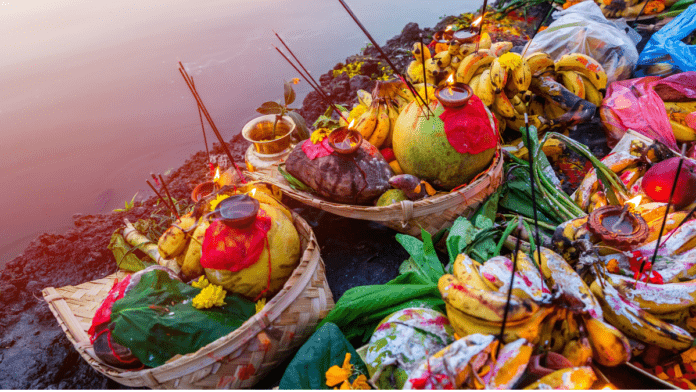Chhath Puja, an ancient Hindu festival, is a remarkable celebration that resonates with devotion and the worship of the sun god. It’s a time when people come together to express their gratitude to the life-giving source, the sun, and offer their reverence through a series of rituals and ceremonies. In this article, we will unravel the mysteries and beauty of Chhath Puja, exploring its origins, significance, rituals, and the profound cultural impact it holds.
Chhath Puja Date: Fri, 17 Nov, 2023 – Mon, 20 Nov, 2023
Table of Contents
Understanding Chhath Puja: An Introduction
Chhath Puja, also known as Surya Shashti, is a four-day festival predominantly celebrated in the Indian states of Bihar, Jharkhand, and the Terai region of Nepal. The festival typically falls in the months of October and November, post-Diwali, and is marked by its deep spiritual and ecological significance.
Origins and Mythological Roots
Chhath Puja has its origins deeply rooted in ancient Indian mythology. According to the Hindu epic, the Mahabharata, it was Draupadi, the wife of the Pandava brothers, who introduced the tradition. Her devotion to the sun god Surya was unshakeable, and it was her relentless dedication that inspired the Chhath Puja we celebrate today.
The Significance of Chhath Puja
Reverence to the Sun God
Chhath Puja is all about expressing gratitude to Surya, the sun god. The sun is regarded as the ultimate source of energy, vitality, and life on Earth. Worshipping the sun is a way of seeking blessings for a healthy, prosperous, and long life.

Environmental Connection
This festival showcases a unique blend of spirituality and environmental consciousness. The rituals include taking a dip in rivers, lakes, or ponds, and standing in water to make offerings to the sun. This is a symbolic way of purifying the environment and conserving water.
Chhath Puja Rituals: A Step-by-Step Guide
Chhath Puja involves a series of rituals observed over four days. Each day has its significance, and they are performed with great devotion and strict adherence to tradition.
Day 1: Nahay Khay
The festival begins with Nahay Khay, where devotees take a holy dip in the river and prepare a meal. The first day focuses on cleansing the body and mind.
Day 2: Lohanda and Kharna
On the second day, known as Lohanda and Kharna, fasting begins. Devotees eat once, and then they observe a stringent fast without water until the next day.
Day 3: Sandhya Arghya
This day is marked by offering Arghya to the setting sun. Devotees stand in water and offer their prayers to the sun. This is a remarkable sight of collective devotion.
Day 4: Usha Arghya
The final day of Chhath Puja, Usha Arghya, involves offering prayers to the rising sun. It’s a mesmerizing moment when the first rays of the sun touch the devotees.

The Vibrancy of Chhath Puja Celebrations
Decorations and Traditional Attire
During Chhath Puja, homes and the ghats near the water bodies are beautifully decorated with earthen lamps, marigold flowers, and banana leaves. Devotees wear traditional attire, usually sarees for women and dhotis for men, to maintain the cultural authenticity.
Singing Chhath Songs (Chhath Geet)
Music and singing are an integral part of the celebrations. Devotees sing Chhath Geet, traditional songs that narrate the history and significance of the festival, creating a melodious atmosphere.
The Deep Spiritual Experience
Mental and Physical Purification
The rituals of Chhath Puja aren’t just for show; they have a profound spiritual impact. Fasting and standing in water are seen as a way to purify the mind and body. It’s a transformative experience for many.
Sense of Unity
Chhath Puja brings people together, transcending barriers of caste, creed, and class. It’s a time when communities unite to celebrate and share their devotion to the sun god.
Read More: Why Do We Celebrate Muharram? Exploring the Significance and Traditions
The Global Reach of Chhath Puja
Beyond India and Nepal
In recent years, Chhath Puja has gained popularity and recognition beyond the borders of India and Nepal. The Indian diaspora has played a significant role in spreading the festival’s essence to various parts of the world.
Recognition and Inclusivity
Chhath Puja has been celebrated in countries like the United States, the United Kingdom, and Australia, with local governments recognizing it as an official festival. This showcases the inclusivity and acceptance of diverse cultural traditions.
Preserving Chhath Puja Traditions
Challenges and Conservation Efforts
While Chhath Puja is deeply rooted in tradition, there are ongoing challenges to preserving its authenticity and relevance. Urbanization, pollution, and changing lifestyles have posed difficulties in conducting rituals.
Community Initiatives
Communities and organizations have been actively working to preserve and promote Chhath Puja. Awareness campaigns, cleaning drives of water bodies, and cultural programs have helped in sustaining the tradition.
Conclusion
Chhath Puja, with its deep spiritual roots, cultural significance, and environmental message, stands as a remarkable celebration that brings people together. It’s a festival that unites individuals in their devotion to the sun god and in their commitment to the environment.
As the sun sets and rises during Chhath Puja, it signifies not only the celestial cycle but also the renewal of hope and the continuation of tradition. The rituals and customs, though challenging, bring a profound sense of unity and purification to those who partake.
Chhath Puja is a cultural gem, a festival that has transcended borders, and a beautiful reminder of the enduring connection between humans, nature, and the divine.
Want to Shopping for Chhath Puja? CampusTreasures
FAQs (Frequently Asked Questions)
1. What is the history behind Chhath Puja?
Chhath Puja’s origins can be traced back to the Mahabharata, with Draupadi playing a pivotal role in its inception. She dedicatedly worshiped the sun god, inspiring the festival.
2. When does Chhath Puja usually take place?
Chhath Puja typically occurs in the months of October and November, following the Diwali festival.
3. What is the ecological significance of Chhath Puja?
The festival promotes environmental consciousness through rituals like taking a dip in water bodies and offering prayers to the sun. It symbolizes the purification of the environment and water conservation.
4. How has Chhath Puja spread beyond India and Nepal?
The Indian diaspora has played a vital role in spreading the essence of Chhath Puja to various countries. It has gained recognition and inclusivity in places like the United States, the United Kingdom, and Australia.
5. What challenges does Chhath Puja face in the modern world?
Urbanization, pollution, and changing lifestyles have posed challenges to preserving Chhath Puja







